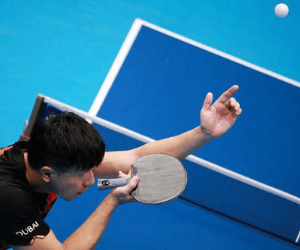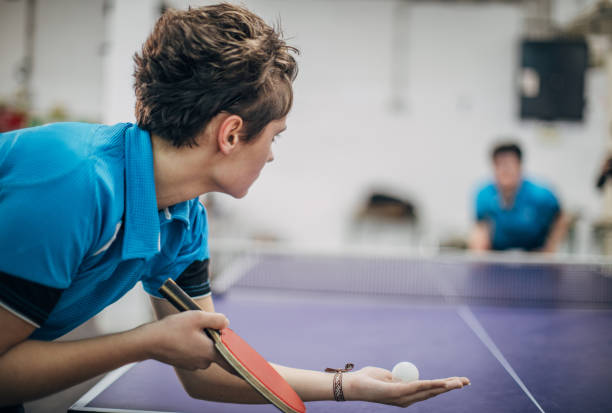When I was younger, my dad taught me and my brothers how to play ping pong. We played by the rules that he learned as a kid. But about five years ago, I attended my first sanctioned table tennis tournament and learned not all his ping pong rules were correct.
- Ping Pong is played with a table, paddles, and balls
- Ping Pong is played by either two or four players
- Players take turns hitting the ball back and forth to each other on the table
- The ball may not bounce twice on the same side of the table
- The player serving first has five chances before it’s their opponent’s turn to serve
- A point is scored if an opponent fails to return the ball in any way
Many players know the basics of table tennis, but there are nuances to playing and scoring correctly, which I cover in this article. After incorporating the official regulations, I found that my ping pong game improved, and we had more fun playing. This article has everything you need to know about the rules, along with some playing tips.

Contents
Ping Pong Rules and Scoring
Table tennis is an excellent sport for friends to play together. Ping pong can be played equally by kids and adults, making it an ideal pastime that doesn’t require too much space or expensive equipment. The rules are simple, but there’s more than meets the eye when playing.
So, if you ask how the points are scored, you’re not likely to get anything essentially different from ‘a miss for my opponent if he cannot return the ball to my side after I hit the ball over to his side of the ping pong table.
If you’re teaching a new player, you may get answers like how an opponent loses a point by missing the ball, missing their side of the table, hitting the ball on the net, or hitting the ball before it bounces on their side of the table.
The aim in any ping pong game should be to win- it’s as simple as that. But there is more than meets the eye with this seemingly straightforward sport; far from superficial knowledge, you have a better chance of coming out ahead if played right.
The rules of ping pong are more than just about how often one hits or misses the ball. They also affect points, how to serve, and order of play in doubles. The game itself may seem easy, but these additional complexities make every match exciting and fun.
Want to know more about the official rules of ping pong? This article is for you. Read on and find out everything needed when someone asks, “Is that a point” or “can he serve it that way.”
Basic rule 1: Scoring, losing, and winning
One of the most basic rules of scoring and winning in ping pong is that a point is scored after the ball has been put into play. The first player to hit the 11-point mark emerges as the winner.
Typically, the rule is that a table tennis match is the best of any odd. Do you remember your odd numbers in elementary mathematics: 3, 5, 7, etc.? Exactly. If you’re able to win the majority of games in a match, then you’re the winner. It is that simple.
Remember that a match can consist of many games; it depends on what you agree to before the game starts. We often play the best of five; you could decide to play best of seven, nine, or any number.
Meanwhile, a winner must establish at least a two-point gap margin to win his opponent. That implies that if the scoreline stands at 10-10, it is deuce, and the ping pong game goes into extra play until a player gains a 2-point lead to win.
Don’t be childish with those old tricks! If you shake the table, touch the net or return serve with your free hand, you just lose a point to your opponent.
Basic rule 2: Acceptable and legal serve
A serve is considered legal and acceptable only when the ball leaves the server’s open hand (palm), and it is tossed up vertically at least 6 cm away from the server’s palm. You must not hide the ball from your opponent, who should have the ability to see the ball when struck.
The critical point is that you can not strike the ball while it’s in your hand. This is one of the rules I learned at my first tournament. I had a habit of serving from my hand, which was unacceptable for tournament play. Nobody wants your surprise package.
Additionally, the server must strike the ball so that it bounces first on the server’s side of the table before it gets to the opponent’s side.
It is essential to bear in mind that the edges (and not the sides) are considered acceptable as the legal surface of the ping pong table. Also, it doesn’t matter who is serving; a player who successfully wins eleven points and leads by two points wins the match.
Basic rule 3: Service Diagonal or anyhow?
A serve is legal only if it is diagonal in doubles play. By being diagonal, we mean that the server takes one right half of his court to serve the ball to the opponent’s right half-court.
In singles matches, your opponent’s entire side of the table is open to your serve. A server takes two serves before the opponent takes over. This rule doesn’t apply when a game goes into extra play. During extra play, one player makes one serve and then switches to another.
Rule 4: The Let Serve rule
The ball must clear the net without touching it when serving. If the ball touches the net or clips it before it bounces on the opponent’s side, there is a re-serve, and the first serve attracts no score. This situation is technically called let serve.
However, if the ball clips the net and returns to the server’s side, the opposing team or player earns a point. A let serve can also be called if the player receiving the serve is not ready and makes no attempt to hit the ball.
What if something external interrupts play? Once play is obstructed by objects or incidents outside the player’s control, a let serve is called, and you can retake your serve. This is common sense!

Rule 5: Serve Switch in Doubles
Unlike in singles, where service is always in a straight line, doubles entails two players standing at each end of the table. The decision of the team to serve first is a function of the agreement between the two teams, say X and Y, and this usually takes place at the start of a game.
When the first player serves, they will get two opportunities to deliver a service. Once these have been used by their team and with no switching allowed during either serve it’s time for the other side of court (opposing) players to take over.
The first player to serve is X1, and he makes two services to Y2. Y1 then serves twice to X2; X2 makes two services to Y2, and then Y2 serves twice to X1. The changeover process continues until a game is completed.
Rule 6: Hitting the ball in Doubles
What’s unique about doubles play? Well, for starters, it has a lot of tactical action. That means players need to switch up hitting the ball. Choosing who receives the service is a strategic decision. Serves and returns alternate to ensure sure all players get an opportunity to hit the ball.
Failure to follow the hitting sequence is a loss of the point. Players at each end of the table must alternate hitting the ball. For example, X1 should not hit the ball twice. So, for instance, if X1 serves and Y2 receives, X2 should return the ball to the opponent’s side, and Y1 hits the ball back to team X.
Rule 7: Caution before hitting
You don’t just hit the ping pong ball. The rule says that the ball must first bounce on your side of the table before hitting it back to your opponent’s side. If you violate this rule, you lose a point.
Similarly, never whack the ball at your opponent, but on the table. If your ball fails to hit your side of the table and goes straight to the opponent’s side, there’s ‘I’m sorry.’ You’ve simply missed a point. And that’s painful, you know. After all, this is not a dodge ball.
Rule 8: Equipment and Color Design
Typically, the color of a tennis ball is either orange or white. It is a 40 mm round in dimension. It is neither spherical nor completely circular. The standard measurement of a tennis table is 2.74 by 1.525 by 0.76 meters in length, width, and height, respectively.
The paddles on either side should come in red and black colors. The table is painted lined with white color halfway on each side. We often use paddles besides red and black when we play at home.
Basic Rule 9: Service and side switch
Switching serves is one of the most critical basic ping pong rules. Each player serves two points in a row before switching to service to the other side. Meanwhile, if a score stands at 10-10, each side takes one serve, earning only one point for a correct hit.
The server is switched. Similarly, after each rally, the team or player at one end of the table switches to the other side. This applies after the 5th game.

Rule 10: 11 points win the game not 21
Oh, sorry, you’re old school. You don’t follow history. The scoring system has long been changed. Well, for fun games, you can agree on 21, but ITTF won’t pardon you if you go to a competition with that ancient scoring model. Games end up in 11 points.
Rule 11: Never hit the ball twice
If you deliberately strike the ball twice in succession, my dear, you’ve just given out a point to your opponent. So, don’t ply that route.
Conclusion
Table tennis is one of the games with easy-to-understand and straightforward rules. You don’t have to rack your brain before you understand. But ping pong rules can change from time to time.
So it’s a good idea to stay on top of the rules in ping pong. You never know when an upcoming competition will be taking place or if any new regulations could affect the game.
It doesn’t matter whether we’re talking local vs. national level events; no one wants to find out at the last minute that a new rule is being used – especially not when you’ve otherwise trained for the competition.

How To Play Ping Pong The Right Way - Old Lyme Town Band
Saturday 30th of January 2021
[…] game table tennis, likewise known as Ping-Pong is an instance of just how a sport once exercised in obscurity, can […]
Basic Ping Pong Rules and How To Play - ArticleCity.com
Friday 10th of January 2020
[…] Jan 10, 2020 by Article City 0 0 Comments Originally Posted On: https://gametablereview.com/ping-pong-rules/ […]